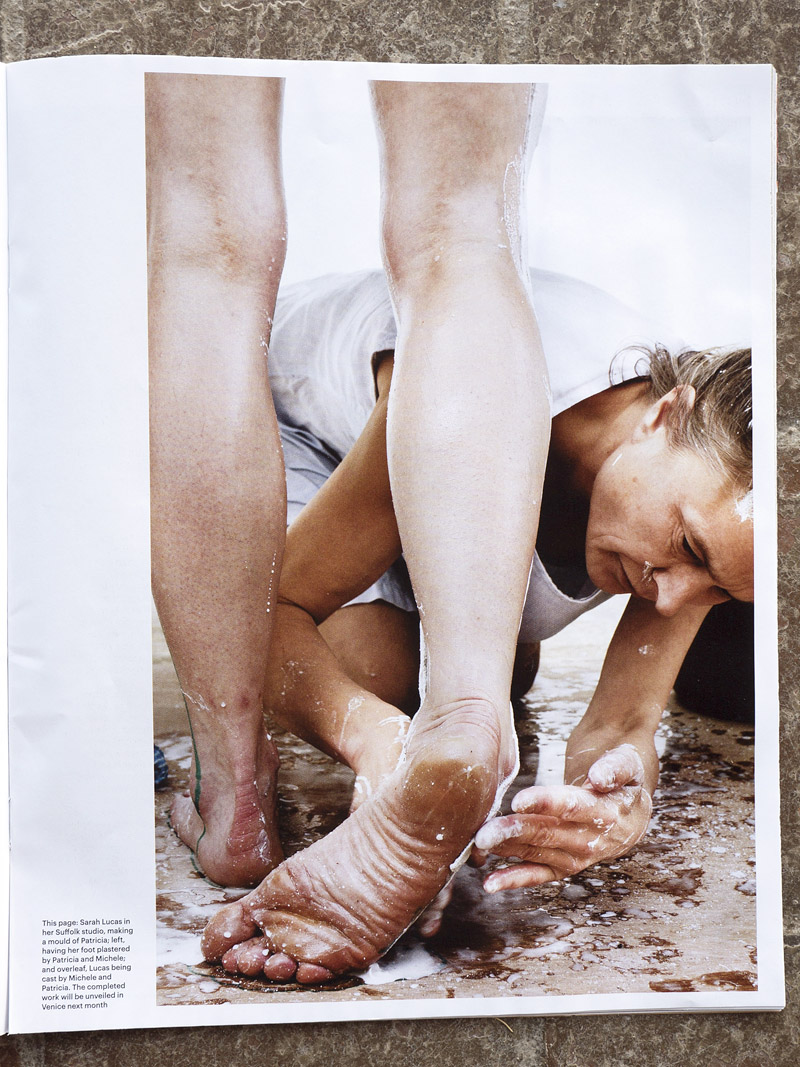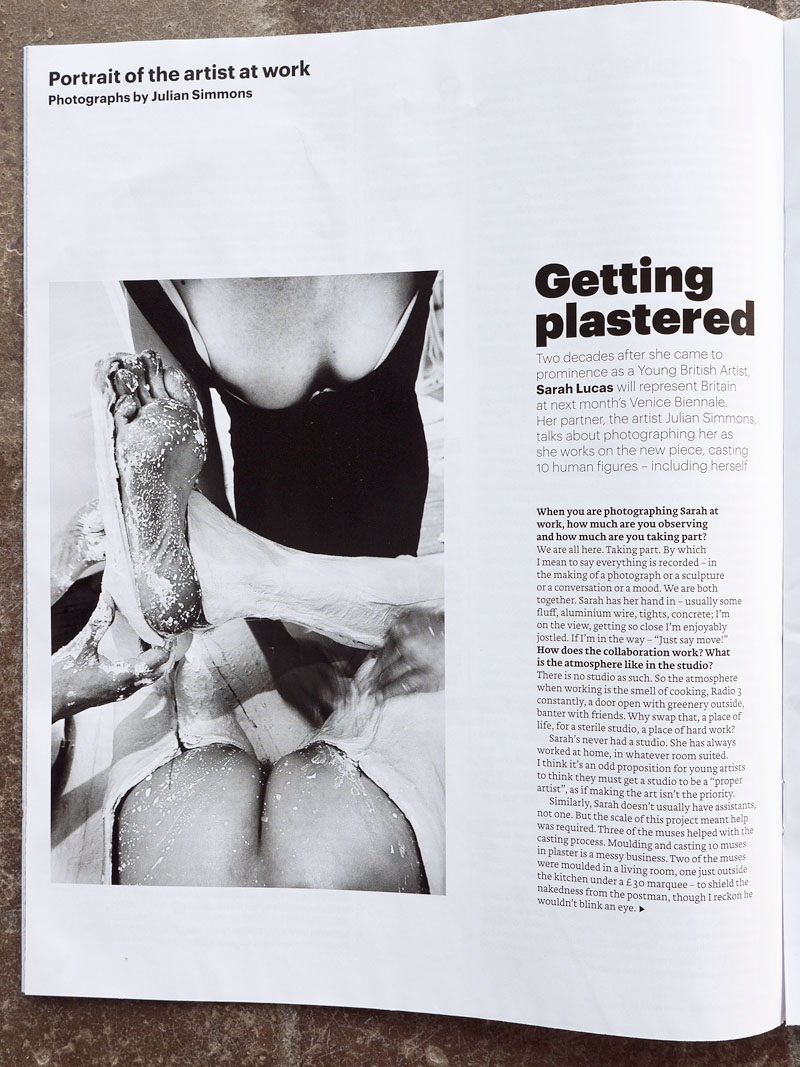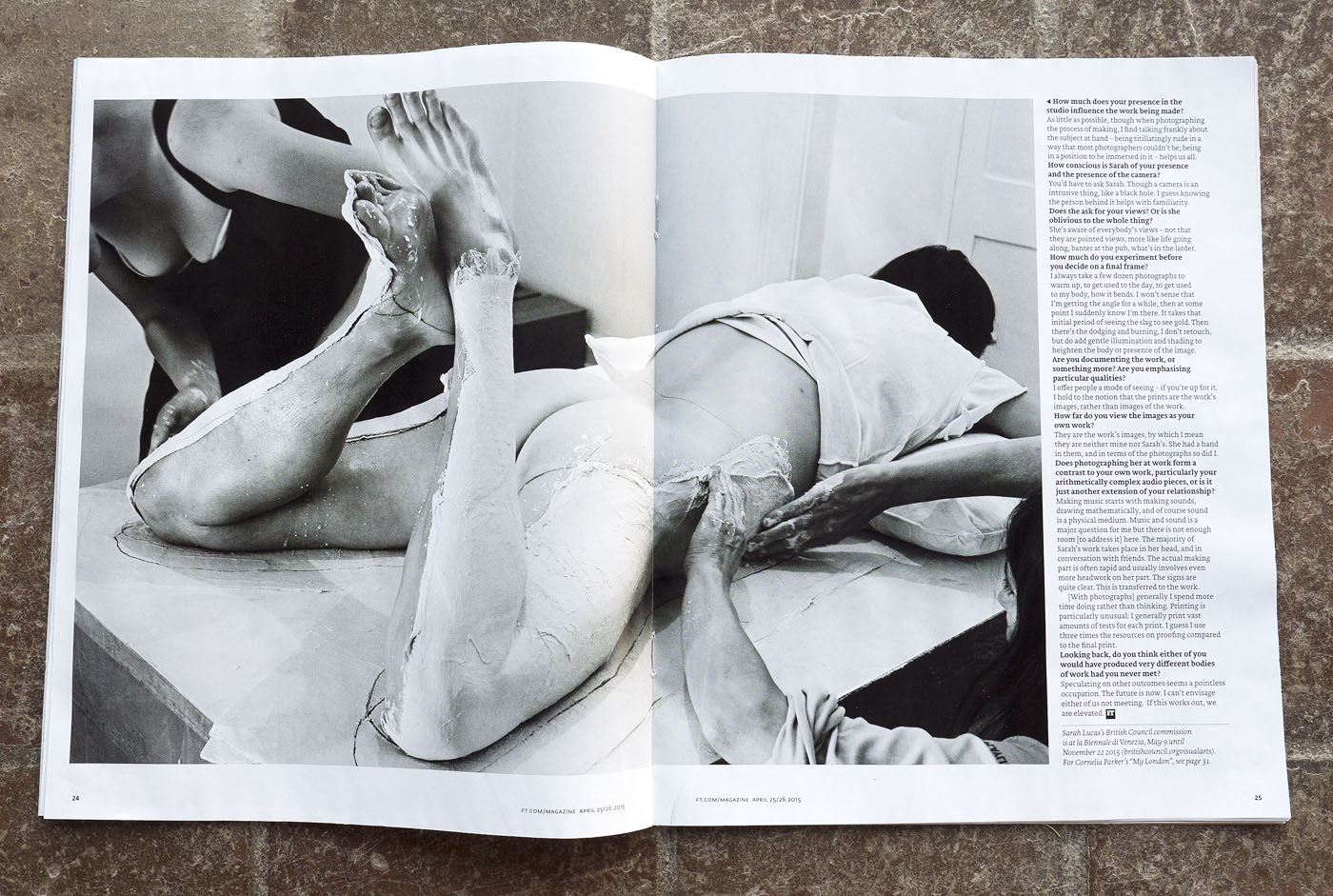‘Hi James, two of the images are of Sarah doing the plastering, the other two are of Sarah getting plastered! …not suggesting final titles but ‘Getting Plastered’ would be a rather nice inclusion. Very best, Julian!’
‘The artist Julian Simmons, talks about photographing Sarah Lucas as she works on a new piece for the Venice Biennale, casting 10 human figures – including herself’, Financial Times, 25 April 2015, FT Weekend Magazine; pages 22-23 & 24-25 centrefold.
Photographs from the book I SCREAM DADDIO.
Questions for Julian Simmons from Liz Jobey at the FT.
Liz edited my slightly unpredictable answers into a more lucid read, but here are the unedited Q&A’s!…
 When you are photographing Sarah at work, how much are you observing? How much are you taking part?
When you are photographing Sarah at work, how much are you observing? How much are you taking part?
We are both together, Sarah has her hand in – usually in some tights, fluff, plaster, concrete or bending aluminum wire; I on the view, getting so close I’m enjoyably jostled – “if I’m in the way just say move!”. No reason for politeness, but generally with one eye in the camera (the left eye), and the other out, seeing where the exterior elbows are flying.
Taking part? We are all here, taking part. By which I mean to say everything is recorded – in the making of whatever, a photograph or a sculpture or a conversation or a mood.
Could you describe how the collaboration works, what is the atmosphere like in the studio? Are there other people present (in this case, the model, obviously)? But how much do you contribute to the process?
As I’ll get onto – there is no ‘studio’ as such. So the atmosphere when working is the smell of cooking, Radio 3 constantly, a door open with greenery outside, banter with friends; why swap that – a place of life, for a sterile studio – a place of hard work?!
Contributing? We are all here, contributing. To exact this, would erase the magic.
Casting the muses was slightly unusual in that it required a larger additional space – up for getting very messy, and private – no Peeping Toms; the solution was a shuttered gallery annex in Mayfair and a workshop deep in Clapton.
Sarah’s never had a studio, always worked at home, in whatever room suited. I think it’s an odd proposition for young artist’s to think they must get a studio to be a ‘proper artist’, as if making the art isn’t the priority!
It often amuses us when an interviewer calls in for a studio visit – expecting to see the ‘show studio’; I think many artists manufacture the look of a studio for such visits, like a piece of theatre, which possibly then reflects on what they get up to when the interviewer isn’t present – an odd revolution. Cooking, elevating instruments, with and without (the outside world), is the practice here.
Molding and casting 10 muses in plaster is a messy business, 2 of the muses were molded in a living room, 1 just outside the kitchen under a £30 marquee – to shield nakedness from the postman. I reckon he wouldn’t blink an eye – but that’s another story, he’d be curious for sure – as we all should be, always.
The other muses, 7, molded in a gallery annex – more suited to the amount of plaster involved.
In a similar way to not having a regular studio, Sarah doesn’t have assistants, not one, but on this occasion the scale of the project meant help was required, 4 of the muses helped with the casting process. When I say not one, there are many friends who on the motive of intrigue and practical necessity lend a hand and their particular pervy wisdom.
How much does your presence in the studio influence the work being made?
As little as possible, though when photographing the process of making which I normally avoid to prevent intrusion, I find talking frankly about the subject at hand – being titillatory rude in a way that most photographers couldn’t be in a position to be immersed in, helps us all.
How conscious is Sarah of your presence, and the presence of the camera?
You’d have to ask Sarah that.
A camera is an intrusive thing, like a black-hole; I guess knowing the person behind it helps with familiarity.
Does she ask for your views, does she consult you? Or is she oblivious to the whole thing?
She’s aware of everybody’s views, not that they are pointed views, more like life going along, banter at the pub, etc, what’s in the larder. It would be ridiculous to suggest any artist, or any person, was oblivious of another.
When you are making an image of Sarah working, where, for you, does the emphasis lie? On her figure and her expressions, on the work and its different views and facets? Or just on the process itself — the sense of being in the middle of things?
As I say I generally avoid this angle, though as a reporter such as yourself I can see that this is a pertinent and tricky question – in need of an answer, or a solution.
Where you exist in relation to the world.
Maybe our example can help?
An image contains the future, now, it propels the next moment.
Do you make multiple photographs to achieve a final composition? How much is it a process of experimentation before you decide on a final frame?
The wisdom 20 years ago was on a roll of 36 frames, was one good frame.
Now with digital, it’s exactly the same, though it’s possible to take many more frames, which is handy for publications. When working I take over 300 photos a day, so that’s 9 ace shots.
I always take a few dozen photographs to warm up, to get used to the day, to get used to my body this day, how it bends; I expect that I won’t sense that I’m getting the angle for a while, at some point I suddenly know I’m there, here. It takes that initial period of seeing slag to see gold. It’s the same with everything, cooking, driving, religion, making love, making war.
Then there’s the dodging and burning, I don’t retouch, but do add gentle illumination and shading to heighten the body or presence of the image.
When you photograph Sarah’s finished works, for example the NUD sculptures, do you change them in any way before you make the image? Or do you approach Sarah’s finished works as you would those of any other individual artist.
I don’t really care about any other artists, by which I mean I’m not that interested in other artists – I’m sure many are good artists, but I do what I do because I can’t find it elsewhere. I don’t change anything, except in the respect that everything is changed by the way someone else sees something. The image is a powerful thing, as is he or she who provides the images.
Do you you feel in this case that you are documenting the work, or something more? Are you emphasising particular qualities in the resulting image?
I offer people a mode of seeing – if you are up for it.
Not a document. I hold to the notion that the prints are the work’s images – rather than images’ of the work.
By which I mean to say, I give you exactly the same image that belongs to the work. This might be a difficult notion to grasp, as we commonly think of images as lesser copies, descendent of the ‘object’ and maybe existing in lesser dimensions. The image I refer to is autonomous to dimension, as it does not operate in the world of stuff that might physically bruise you, and is in many way antecedent to the object – it is that which holds the object up and out – a scaffolding of notion.
How far do you view the images as your own individual work?
As above, they are the work’s images, by which they are neither mine nor Sarah’s. She had a hand in them, and in terms of the photographs so did I. Sarah might say the fairies had a hand in them.
Of course the view is my work, it is where I was – that is what is partially recorded, and plainly evident when I view the photographs – where my left-eye was when I ‘took it’. The Mind Behind. Look at anything that has had human involvement and it is possible to ‘step behind’ your view to witness the mind that presented it.
There are many books of Sarah’s work, all of them with photographs, but only a few which have your participation. How would you describe your approach to working with her for these images in these books, and what distinguishes them from the other books?
I handle the sculptures in a way others might not be permitted – except Sarah of course. I have a series of photographs taken by Sarah, of a NUD on my nob, a NUD handling me.
Design that distracts from the image on the page is poor design, un-clever to be sure. I’d describe what I aim for as unsophisticated design; the sophists (sophisticates) were employed in ancient Greek times to tell a web of convincing untruths for those in power, we have the same now but they aren’t know as sophists, we call them by the ugly name of spin-doctors, in anycase in terms of design, I’m unsophisticated. My style is confidently pared-down, sensitive to the subject, efficient. On this thread, I admire the cynics, they sat in bath-tubs in the middle of the street, being contrary. Most notions of definition, these-days, are 180 degrees out; worth noting, worth experimenting with – in one’s own head.
Compared to your other work — particularly the audio work which seems so complex and so mathematical in its construction, though not in its results — Sarah’s work is so haptic, so physical. Is it in any way relaxing for you to photograph her work like this? Does it form a contrast to the rest of your work, or is just an extension of your artistic and personal relationship.
The majority of Sarah’s work takes place in her head, and in conversation with friends, the actual making part is often rapid and usually involves even more head-work on her part, so we’re talking about a massive amount of head-work in total! – don’t you notice? – the signs are quite clear. This is transferred to the work.
Generally I spend more time doing, rather than thinking.
Printing is particularly unusual, I generally print vast amounts of tests for each print, I guess I use 3 times the resources on proofing compared to the final print.
Music and sound is a major question for me, important, not enough room here, ask me again as a singular subject. As a subject it’s flooded with material and stances, a brilliant period, now, for sure, but the notion of philosophic music and sound is worth sorting out, though as I say not just here.
Making music starts with making sounds, drawing mathematically, and of course sound is a physical medium, especially at the level with which I form these sounds – at a textural level (white-noise manipulation).
Check this out for my approach to audio: NUMBERSTREAM.
Looking back, do you think either of you would have produced very different bodies of work had you never met?
The future is now. Walking is leaning forward. I can’t envisage either of us not meeting.
Speculating on other outcomes seems a pointless occupation – there’s too much real endeavor for that; we are here, and I trust you are too, just now, if this works out, we are elevated.
Fag Butt, you’ll have to see it.
The subject of this article relates to the exhibition publication : I SCREAM DADDIO

